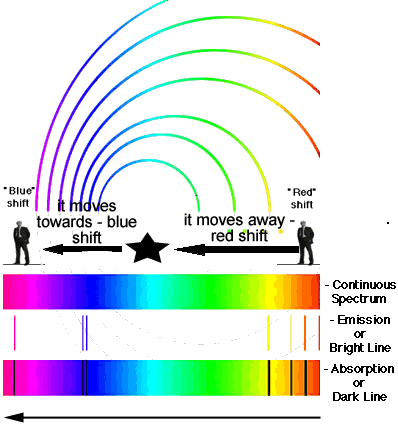Doppler Effect and Red Shift Click here for a PowerPoint on Redshift
The fact that a star, or any light source, is moving toward or away from you does not affect what it emits - it affects what you (as the observer) perceive it emitting. The apparent shift of wavelength of light toward the red red of the spectrum when the emission source is moving away from us, or toward the blue end when the emitter is moving toward us, is called the Red Shift - for sound it is called the doppler shift.
Light consists of fluctuations in, or waves of the electromagnetic field. The wavelength (or distance from one wave crest to the next wave crest) of light is extremely small — for visible light it ranges from four to seven ten millionths of a meter (400nm – 700nm), The different wavelengths of light are what the human eye sees as different colours because they are sensed in different proportions by the cones. The longest wavelengths appear in the red end of the spectrum and the shortest appear in the blue end. Imagine a source of light at a constant distance from us, emitting waves of light at a constant wavelength. Obviously, the wavelength of the waves we receive will be the same constant wavelength at which they are emitted by the source. Suppose now that the source starts moving directly toward us. When the source emits the next wave crest, it will be nearer to us, so the distance we will see between the two wave crests arriving will appear to be smaller than when the star was stationary. This means that the wavelength of the waves we receive will be shorter (or shifted toward the blue end of the spectrum) than when the source was not moving. Similarly, if the source is moving away from us, the wavelength of the waves will appear slightly longer, or shifted toward the red end of the spectrum. The relationship between wavelength and speed is called the Doppler effect.
Different types of redshifts have different causes attributed to them at higher levels of study. At GCSE it is easiest to think of the Doppler type shift as this has been experienced by you in the sound context. You do not have to worry abuot the other two at all - but you may want to 'Google' them and find out more! (Observed wavelength - Rest wavelength)/(Rest wavelength) = (v/c) so long as the velocity v is much less than the speed of light. A relativistic doppler formula is required when velocity is comparable to the speed of light.
|
Follow me...
|






